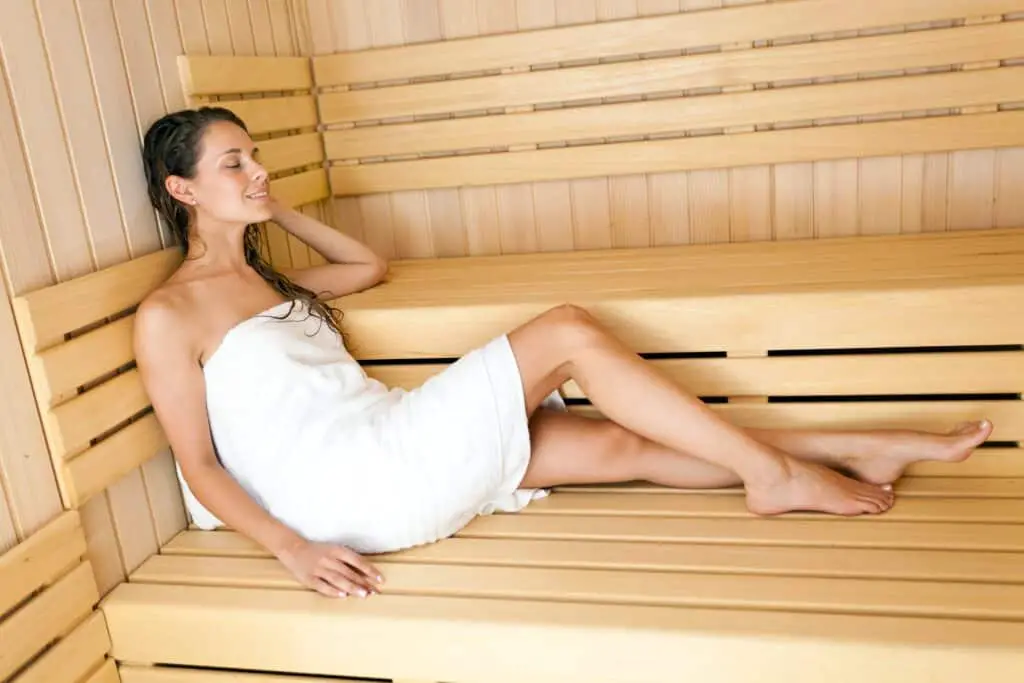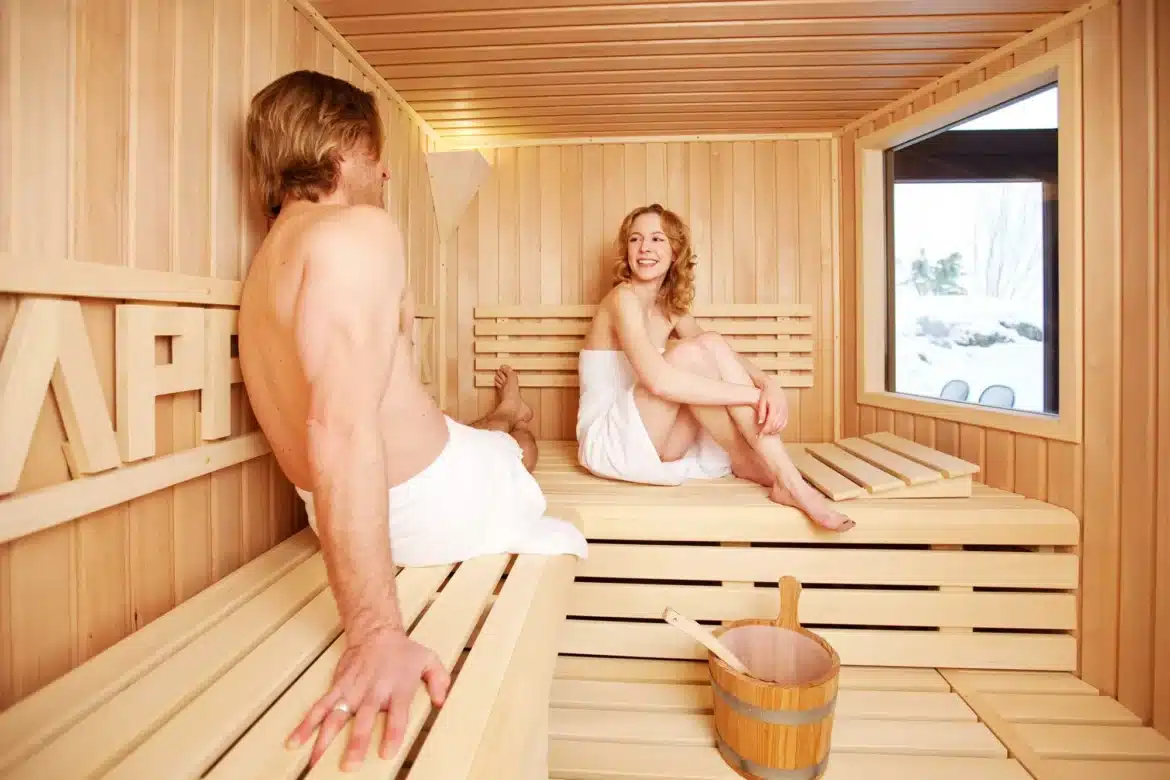Introduction
How Long To Stay In Sauna For Weight Loss: Saunas have been cherished for centuries across various cultures for their therapeutic and relaxation benefits. In recent times, they have also gained popularity as a potential tool for weight loss. The idea of shedding pounds while sitting in a room filled with soothing heat may seem appealing The relationship between saunas and weight loss is a topic of interest for many individuals seeking effective ways to achieve their fitness goals. In this exploration, we will delve into the factors that influence how long one should stay in a sauna for weight loss, the potential benefits and risks involved, and the science behind this intriguing connection.
So, if you’re curious about harnessing the power of saunas for your weight loss journey, read on to discover the key insights and considerations that can help you make informed decisions about your sauna sessions. Saunas contribute to weight loss through a process called thermogenesis. The high heat induces sweating, which can lead to temporary water weight loss. However, this weight loss is primarily due to fluid loss and may be regained upon rehydration. Extended sauna sessions can also increase heart rate and calorie expenditure, potentially aiding in fat loss over time.
One of the critical aspects to consider is maintaining proper hydration. The intense heat of the sauna can lead to excessive sweating, resulting in fluid loss. It’s crucial to drink plenty of water before, during, and after your sauna session to prevent dehydration. Dehydration can be dangerous and counterproductive for weight loss.
The ideal duration for a sauna gym session varies from person to person. Factors such as age, fitness level, overall health, and personal tolerance to heat play a significant role in determining how long one should stay in a sauna. It’s essential to listen to your body and not push yourself too hard.

Is A sauna good for losing Belly fat?
A. It is a myth that sitting in a sauna can help you decrease additional fat. But it is not valid. A sauna does not enable you to lose weight; it temporarily eliminates quickly replaceable water from the body.
Saunas and Weight Loss
Saunas have been used for centuries as a means of relaxation and improving overall well-being. Sauna sessions involve sitting in a heated room, typically around 150-195°F (65-90°C), which induces sweating and increases the body’s core temperature. This process may lead to some weight loss, but it’s important to understand that this weight loss is primarily due to water loss through sweating, not the burning of fat.
Here’s how saunas affect weight
Water Weight Loss: When you sit in a sauna, you sweat profusely, causing your body to lose water. This can lead to temporary weight loss, but it’s not a sustainable or effective method for long-term fat reduction.
Calorie Burn: Sauna sessions can increase your heart rate and metabolism slightly, leading to the burning of some extra calories. However, the calorie burn is relatively modest compared to other forms of exercise.
Fat Loss: Saunas do not directly target belly fat or promote fat loss in specific areas of the body. Fat loss occurs when you create a calorie deficit through a combination of diet and exercise.
Is A Hot sauna good for weight loss?
Takeaway. Saunas can help lose water weight, but you’ll gain it back after rehydrating. Higher temps do cause a temporary increased heart rate and calorie burn, though — but it’s prob not dramatic enough to contribute to long-term weight loss.
How Saunas Influence Weight Loss
Increased Heart Rate: Sitting in a hot sauna can lead to an increase in heart rate, similar to what happens during mild to moderate physical exercise. This can result in burning a few extra calories. However, the calorie burn from a sauna session is relatively modest compared to traditional forms of exercise.
Relaxation and Stress Reduction: Sauna use can promote relaxation and reduce stress, which can indirectly support weight management. High stress levels are associated with emotional eating and weight gain, particularly in the abdominal area.
Detoxification: Some proponents claim that saunas aid in detoxification by promoting sweating, which helps eliminate toxins from the body. However, the extent to which saunas effectively detoxify the body is a subject of debate among experts.
Limitations and Considerations
Temporary Weight Loss: The weight lost through sweating in a sauna is primarily water weight and is quickly regained when you rehydrate. It does not represent fat loss.
Individual Variability: The impact of saunas on weight loss varies among individuals. Factors like age, gender, metabolism, and overall health play a role in how individuals respond to sauna sessions.
Hydration: Prolonged sauna use can lead to dehydration, which can be dangerous. It is crucial to stay well-hydrated before, during, and after sauna sessions.
Is 10 minutes in sauna enough?
Among other benefits, regular sauna use can help relax muscles, improve blood flow, and bolster skin health. The recommended length of time to spend in a sauna is 15-20 minutes.
Is 10 Minutes in a Sauna Enough
Goals: If your primary goal is relaxation and stress reduction, a 10-minute session can be quite effective. The soothing heat and calming environment can help you unwind and de-stress quickly.
Circulation: A short sauna session can also lead to improved circulation, although the extent of benefit may be less compared to longer sessions.
Detoxification: If your aim is detoxification, some experts argue that a longer session may be needed to trigger more significant sweating and toxin elimination. However, this is a matter of debate, and the benefits of detoxification through saunas are still being studied.
Pain Relief: For relief from muscle or joint pain, a 10-minute session may provide some comfort. However, longer sessions might be more effective in addressing chronic pain issues.
Individual Tolerance: The duration of a sauna session should be based on your individual tolerance to heat. If you’re new to saunas or have medical conditions, it’s essential to start with shorter sessions and gradually increase the time as your body adapts.
How long does it take to lose 2 pounds in a sauna?
How long to sit in sauna to lose weight? About 15-20 minutes in sauna will give you good results. How much water weight can you lose in a sauna? You can lose about 2 pounds of water weight in sauna.
Factors Affecting Sauna-Induced Weight Loss
Duration: The longer you spend in a sauna, the more you are likely to sweat and lose water weight. However, spending excessive time in a sauna can lead to dehydration and other health risks.
Temperature: Higher sauna temperatures generally lead to more sweating and greater water loss. However, extremely high temperatures can be uncomfortable and even dangerous.
Realistic Expectations
Losing 2 pounds of body fat in a sauna is not a realistic goal, as saunas do not directly target fat cells. Instead, saunas can help you lose 2 pounds of water weight relatively quickly, but this weight will be regained as soon as you rehydrate.
A typical sauna session of 15-30 minutes can result in the loss of approximately 0.5 to 2 pounds of water weight, depending on the factors mentioned above. However, it’s important to emphasize that this weight loss is temporary, and it is not an effective long-term method for fat reduction or sustainable weight loss.
Health Considerations
Prolonged and excessive sauna use can lead to dehydration, overheating, and electrolyte imbalances, which can be harmful to your health. It’s crucial to stay well-hydrated and listen to your body’s signals during sauna sessions. If you have any underlying medical conditions or concerns, consult with a healthcare professional before using a sauna for weight loss.
Is A sauna good for your skin?
Collagen — the protein in our skin responsible for elasticity — gets a healthy kick when you spend time in a sauna. The hot air combined with moisture enhances collagen production to help rejuvenate your complexion. The heat increase also allows your skin to shed dead skin cells and make way for new, healthier ones.
Skin Benefits of Saunas
Cleansing and Detoxification: Sweating in a sauna can help open up pores and promote the removal of dirt, oil, and impurities from the skin. Some proponents argue that saunas can aid in detoxification, although the extent to which this occurs is a subject of debate.
Improved Circulation: The heat in saunas causes blood vessels to dilate, leading to increased blood flow. Improved circulation can help deliver more oxygen and nutrients to the skin, potentially promoting a healthy and glowing complexion.
Stress Reduction: Sauna sessions are known for their stress-relieving effects. Reduced stress levels can have a positive impact on the skin, as stress is often associated with skin problems such as acne and premature aging.
Relaxation: The relaxation experienced in saunas can contribute to a more refreshed and youthful appearance by reducing the appearance of stress lines and wrinkles.
Pain Relief: Heat therapy in saunas can alleviate muscle and joint pain, making it easier to maintain an active lifestyle, which in turn can benefit skin health.
Is steam room better than sauna?
The takeaway. Both saunas and steam rooms can help ease muscle pain and tension and benefit the skin. But saunas have been more extensively researched and have a leg up for cardiorespiratory, immunity, cognitive, and overall longevity benefits. If you’re new to heat therapy, be sure to ease into it slowly.
Comparing Steam Rooms and Saunas
Heat and Humidity
Steam rooms have higher humidity levels due to the presence of steam, making it easier to breathe and potentially providing relief for respiratory issues.
Saunas offer dry heat, which can be more intense but may feel more tolerable to some people, especially those who prefer less humidity.
Sweating
Both steam rooms and saunas induce sweating, which can help detoxify the body, improve circulation, and promote relaxation.
Steam rooms may cause more immediate and profuse sweating due to the high humidity.
Skin Benefits
Steam rooms are often considered better for the skin because the high humidity can open pores, cleanse the skin, and potentially improve complexion.
Saunas, while still beneficial for the skin, may be less effective in terms of deep cleansing due to the low humidity.
Respiratory Health
Steam rooms are generally preferred for individuals with respiratory conditions like asthma or allergies, as the moist air can help soothe the airways.
Saunas may not be as well-suited for those with respiratory issues due to the dry heat.
Relaxation
Both steam rooms and saunas provide relaxation benefits. The choice between the two often comes down to personal preference regarding the type of heat and humidity that is more soothing.
What do you wear to a sauna?
Wearing something comfortable made of cotton is the best thing you can wear in a sauna. A classic oversized t-shirt, a loose-fitting cotton towel, and shorts are always good for the sauna. They allow your skin to breathe freely; this helps you enjoy a sauna session to its full potential.
Towel Wrap
Some saunas may allow or even encourage visitors to wear a towel wrap instead of a bathing suit. A towel wrap should be large enough to cover your body adequately.
It’s customary to sit on a towel to maintain cleanliness and prevent sweat from coming into direct contact with the sauna bench.
Nude or Naturist Saunas
In certain cultures or private saunas, nudity is the norm. Visitors may choose to go fully nude in these settings.
If you plan to visit a nude or naturist sauna, be sure to research and follow the specific rules and etiquette of that facility.
Footwear
In most saunas, it is customary to go barefoot. Saunas are typically clean environments, and shoes are generally not allowed to prevent dirt and debris from entering.
However, it’s essential to check the rules of the specific sauna facility you plan to visit, as some may require specific footwear or provide disposable foot coverings.
Accessories
In addition to your chosen attire, consider bringing a small towel to wipe off sweat and a water bottle to stay hydrated during your sauna session.
You may also want to bring a robe or cover-up for when you leave the sauna to maintain modesty and comfort.
Does sauna burn calories after workout?
Yes, research has shown that saunas help the body burn calories. Not only does sweating burn calories, but saunas increase the heart rate by as much as 30 percent which contributes, too. The number of calories burned in the sauna will depend on an individual’s unique body and how much energy they use while sweating.
How Saunas Work
A sauna is a heated room or chamber where individuals are exposed to high temperatures, typically ranging from 150°F to 195°F (65°C to 90°C). Sauna sessions induce sweating, elevate the body’s core temperature, and increase the heart rate, which can create the impression of an intense workout without physical exertion.
Calorie Burn in a Sauna
Calorie Expenditure: The calories burned in a sauna session primarily result from the body’s efforts to maintain a stable core temperature and not from strenuous physical activity. The actual calorie burn is minimal, with estimates ranging from 100 to 300 calories burned per 30-minute sauna session, depending on factors like body size and temperature.
Water Weight Loss: The initial weight loss experienced in a sauna is mainly due to water loss through sweating, not fat loss. This weight loss is temporary and is quickly regained when you rehydrate.
Heart Rate Increase: Sauna sessions can elevate your heart rate, but the increase is generally lower and more controlled compared to traditional cardiovascular exercises like running or cycling.
Dehydration Risk: Prolonged or excessive sauna use can lead to dehydration, which can be dangerous. It is crucial to stay well-hydrated before, during, and after a sauna session to avoid potential health risks.

Conclusion
In the pursuit of weight loss, the allure of saunas as a potential tool cannot be denied. The question of how long to stay in a sauna for weight loss has been thoroughly explored, revealing a nuanced approach to harnessing the benefits of this age-old therapeutic practice. While saunas can indeed contribute to weight loss by promoting thermogenesis, increasing calorie expenditure, and inducing sweating, it is vital to exercise caution and mindfulness.
The key takeaways are clear: listen to your body, prioritize hydration, and understand that individual factors play a significant role in determining the ideal sauna duration. Starting with shorter sessions and gradually extending the time as your tolerance increases is a prudent strategy. Moreover, seeking guidance from healthcare professionals or fitness experts can provide invaluable insights tailored to your unique needs and goals. Saunas, when used sensibly and in conjunction with a balanced diet and regular exercise, can be a valuable component of a holistic Saunas weight loss regimen. They offer relaxation, stress relief, and a potential boost to your metabolism.
However, it’s crucial to maintain a delicate balance between the benefits and the risks associated with sauna use. The sauna’s role in weight loss is one that holds promise, but it must be approached with mindfulness and moderation. As you embark on your weight loss journey, remember that consistency, self-care, and a comprehensive approach to health will yield the most sustainable and lasting results.

